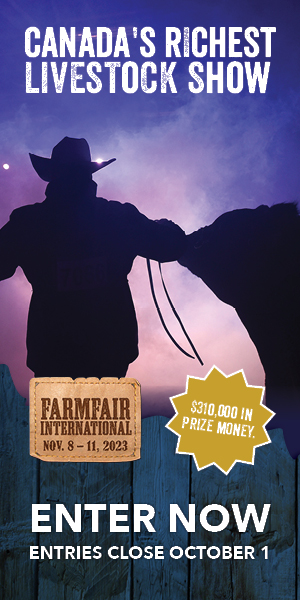AB Direct - Steers
Rail: ---
AB Direct - Heifers
Rail: ---
US Trade- Steers
Rail: 290.00 (IA)
US Trade - Heifers
Rail: 290.00 (IA)
Canadian Dollar
0.02

Transforming animal health education in real-time on W.A. Ranches
“Having a 1,000-head cattle ranch as part of our facility at the University has been a game changer, providing students with a connection to the land and the cattle and making the University of Calgary’s already exceptional Faculty of Veterinary Medicine become one of the most sought-after programs on the continent.”
Dr. Ed Pajor, Professor of Animal Behaviour and Welfare and Ranch Director, W.A. Ranches.
“Since its transformative $44 million gift to the Faculty of Veterinary Medicine from owners J.C. Anderson and his daughter Wynne Chisholm, in the Fall of 2018, one of our goals and visions is to provide collaborative research for the benefit of beef producers.”
In the following study, W.A. Ranches researches the costs and benefits of preconditioning calves with a focus on reduction in antimicrobial use and antimicrobial resistance.
Can management practices reduce antimicrobial use in the beef industry?
It’s a common and costly problem for beef producers: Calves developing potentially fatal Bovine Respiratory Disease (BRD) at the feedlot, which can result in animals suffering and significant economic losses.
BRD is the costliest disease for producers, accounting for up to 70% of all beef cattle morbidities and the primary cause of beef cattle mortality in feedlots across North America.

“Stress can cause immune suppression in the calf, especially when multiple stressors occur in a short period of time,” says Dr. Karin Orsel, DVM, PhD, a professor and cattle disease expert in the University of Calgary’s Faculty of Veterinary Medicine (UCVM).
Orsel and a consortium of researchers are doing a deep dive into preconditioning. Many components of preconditioning have proven weight gains; however, there is still limited uptake from the industry. One question raised from feedlot owners was whether preconditioned calves would still outperform commercial calves when commingled.
They’re investigating whether low-stress handling on the ranch, combined with gradual weaning and a schedule of vaccinations “preconditions” them to better adapt to feedlot life.
Fewer sick calves would mean a reduction in the use of antibiotics. That would provide not only a solution to the cattle industry, but also a defense against antimicrobial resistance.
Study enlists the help of calves at W.A. Ranches
The researchers raised 250 calves at W.A. Ranches for the project. They bought another 250 at auction and housed calves in groups of 100 at the feedlot pens at Olds College. Two pens had either auction-derived or W.A. calves; the other three pens had different ratios of the two groups mingled.
“It’s a big antimicrobial resistance project and really multidisciplinary,” says Orsel, who is collaborating with two UCVM researchers, Dr. Ed Pajor, PhD, an animal welfare and behaviour expert, and Dr. Frank van der Meer, DVM, PhD, who specializes in bovine virology.
The project draws on the expertise of cattle economists Kathy Larson at the University of Saskatchewan and Dr. Henry An, PhD, at the University of Alberta, as well as Dr. Trevor Alexander, PhD, a microbiologist at Agriculture and Agri-Food Canada in Lethbridge, and Sean Thompson, a livestock feed and nutrition researcher at Olds College.

“Dr. Frank van der Meer is looking at the calves’ respiratory microbiome — the population of bacteria in their noses — and Dr. Ed Pajor is studying behaviour of calves,” explains Orsel. “With my students, I’m looking at epidemiology — the rate of illness and death at the feedlot. They’re also studying the implications of preconditioning on a variety of other issues.”
What We’re Reading | Canadian Cattlemen’s Foundation kick-starts youth program at W.A. Ranches
Calves bought at auction generally have an unknown vaccination history or information on weaning strategy, distance travelled, etc. We know from our own studies that approximately 50% of calves on arrival have low or no antibody titres against common BRD pathogens. Also, when vaccinated on arrival, it can be challenging for the calves’ compromised immune system to successfully respond to vaccination.
At the feedlot, calves from multiple sources are grouped together in pens, which of course, greatly increases the risk of BRD rapidly spreading.
Preconditioning trials
“For the calves at W.A we used a fence-line weaning method. We gave them second shots of vaccines and a week later moved them to a different location with feed bunks and easy access to water.” When moved to the Olds feedlot pens, calves were bunk broke and familiar with troughs and bunks for food and water,” says Orsel.
Comparing calves raised with different methods
Orsel compared several groups of calves at the feedlot. One pen had only preconditioned calves from W.A. Ranches, one pen housed auction calves, and three other pens were a mix of the two in different ratios.

“The big difference with the W.A. calves is they’ve been gradually separated from their moms,” says Orsel. “Along with being raised with low-stress handling, we think the vaccination protocol used will result in their immune systems responding better to the challenges they may experience when being moved to the feedlot.”
Additionally, Orsel says that the stressors, like weaning, vaccination, transportation and mingling, are now spread out over a two-month period.
Once completed, the project findings will add to the body of evidence around the costs and benefits of preconditioning in animal welfare, disease prevention and reduced antimicrobial use.
“We want to see if W.A. calves will still benefit from preconditioning if they’re mixed in with auction calves,” says Orsel. “Ultimately, we’re going to evaluate whether these handling practices and preconditioning practices will pay off.”
According to Orsel, findings from the project will be published in Summer 2021.
This project is funded as part of the Major Innovation Fund focused on antimicrobial resistance and through the Alberta Agriculture and Forestry grant and further supported by Alberta Beef Producers.
Reprinted with permission from the University of Calgary.
This article was published in the May 2021 edition of ABP Magazine. Stay tuned to ABP Daily to see more content from the magazine, and update your contact information to receive the next issue.
Photo: Christian Heckle, Prairie Rose Photography
Leave a Comment
Add abpdaily.com to your home screen
Tap the menu button next to the address bar or at the bottom of your browser.
Select ‘Install’ or ‘Add to Homescreen’ to stay connected.



Share this article on